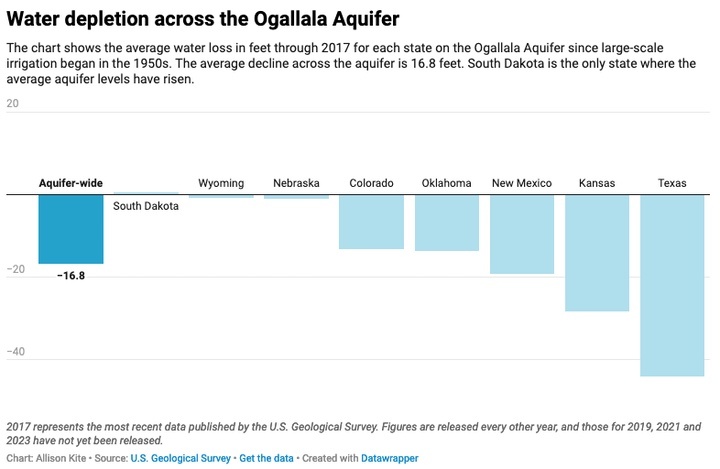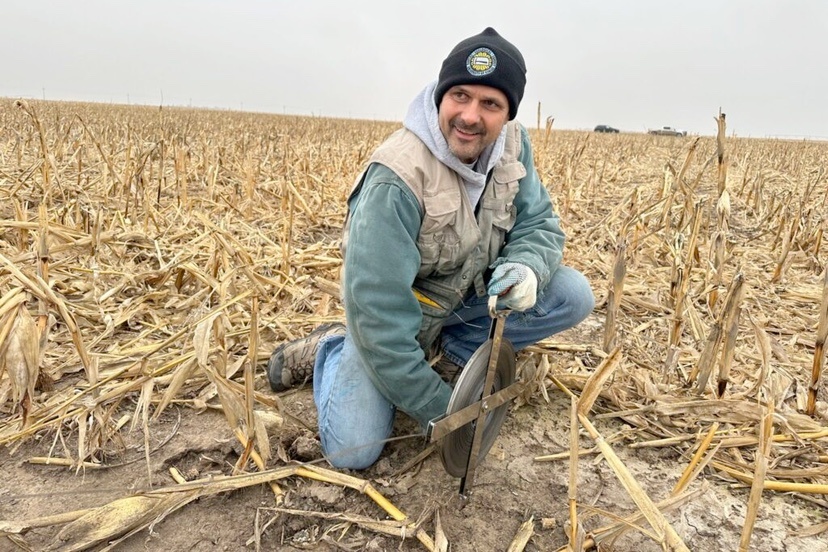Photo: Brownie Wilson kneels next to a decommissioned irrigation well outside Moscow, Kan., as part of the Kansas Geological Survey’s efforts to measure the decline of the Ogallala Aquifer. (Kevin Hardy/Stateline)
This story by Allison Kite and Kevin Hardy appeared on Colorado Newsline on January 30, 2024. It’s the first in an occasional series about water challenges facing the American heartland, from a partnership between Stateline and the Kansas Reflector. We are sharing it in two parts.
Brownie Wilson pulls off a remote dirt road right through a steep ditch and onto a farmer’s field.
He hops out of his white Silverado pickup, mud covering nearly all of it except the Kansas Geological Survey logo stuck on the side with electrical tape. Dry cornstalks crunch under his work boots as he makes his way to a decommissioned irrigation well.
He unspools a steel highway tape measure a few feet at a time and feeds it into the well until gravity takes over. He keeps a thumb on it to control the speed.
How much of the tape comes out wet lets him calculate how much water has been lost here.
Wilson crisscrosses western Kansas every January to measure wells and track the rapid decline of the Ogallala Aquifer, which contains the nation’s largest underground store of fresh water. Last year, some wells had dropped 10 feet or more because of the severe 2022 drought. But this year, they stayed about the same or dropped a couple feet. Some of these wells have dropped more than 100 feet since Wilson started working for the agency in 2001, he said.
“Some of our issues looking forward look gargantuan,” Wilson said. “But I do think we can peck away at it and make some headway.”
The Ogallala Aquifer, the underground rock and sediment formation that spans eight states from South Dakota to the Texas panhandle, is the only reliable water source for some parts of the region. But for decades, states have allowed farmers to overpump groundwater to irrigate corn and other crops that would otherwise struggle on the arid High Plains.
Now, the disappearing water is threatening more than just agriculture. Rural communities are facing dire futures where water is no longer a certainty. Across the Ogallala, small towns and cities built around agriculture are facing a twisted threat: The very industry that made their communities might just eradicate them.

Kansas Democratic Gov. Laura Kelly acknowledges some communities are just a generation away from running out of water. But she said there’s still time to act.
“If they do nothing, I think they’re going to suffer the consequences,” Kelly said in an interview.
Today, the aquifer supports 20% of the nation’s wheat, corn, cotton and cattle production and represents 30% of all water used for irrigation in the United States.
Depletion is forcing aquifer-dependent communities across the region to dig deeper wells, purchase expensive water rights from farmers, build pipelines and recycle their water supplies in new ways to save every drop possible.
Since the mid-20th century, when large-scale irrigation began, water levels in the stretches of the Ogallala underlying Kansas have dropped an average 28 feet farther below the surface, far worse than the eight-state average of 17 feet.
Water levels in Texas, where the Ogallala runs under the state’s panhandle, have dropped 44 feet. New Mexico has seen a 19-foot decline.
In Colorado, Nebraska, Oklahoma and Wyoming, the water level has declined less than the eight-state average, while in South Dakota it has risen.
While the Ogallala Aquifer presents distinct circumstances, tensions over groundwater are growing across the country, said climate scientist and author Peter Gleick, who founded the Pacific Institute, a global water think tank.
“You’re not alone,” Gleick told Kansas irrigators and policymakers at the Governor’s Conference on Water, held in November in Manhattan, Kansas. “A lot of the issues that you’re dealing with in Kansas, they’re dealing with in Arizona, and the Colorado [River] basin.”
Without drastic measures, some communities may not survive.
“I think, without a doubt, we will see some communities dry up,” Gleick said in an interview. “We’ve seen that historically, where communities outgrow a natural resource or lose a natural resource and people have to move to abandon their homes.”
When Micheal Shannon got his start in local government over 40 years ago, water supplies were not top of mind.
Those days are gone.
“We’re running out of water,” said Shannon, the interim city manager in Guymon, Oklahoma. “We’re pumping our maximum. And the water levels keep coming down.”
The largest city in the Oklahoma Panhandle, Guymon relies on 18 wells to draw water from the Ogallala. But dropping water levels have forced the city of about 13,000 to explore new wells outside of town.
The city has already committed some $4.5 million to study and drill new wells, but there’s no guarantee the wells will produce a reliable water supply.
“There’s always that what if,” he said. “There could not be any water.”
The city’s largest water user and employer is a massive pork plant that slaughters and processes more than 20,000 hogs per day. The plant has voluntarily reduced water usage by nearly half during times of shortened supply.
Shannon said the city, industry and agricultural producers must work together.
“We all still want to be here the next 35, 40 years,” he said. “We know farmers are going to have to produce ag products. And the citizens of Guymon are going to have to have water.”
More than 200 miles away, several New Mexico communities are banking on more drastic measures.
A new pipeline, expected to cost more than $800 million, will bring water from the Canadian River’s Ute Reservoir to four municipalities and Cannon Air Force Base.
“This is our future, no doubt about it,” said Orlando Ortega, administrator of the Eastern New Mexico Water Utility Authority. “Without this project, none of these communities could exist for very long.”
The pipeline is being funded largely by the federal government, though four participating communities have been paying dues to the water authority for years. Officials aim to have the pipeline operational by the end of the decade.
Even so, communities will still need to get more aggressive about conserving water, said Michael Morris, who leads the water authority board and is mayor of Clovis, one of its member communities.
Morris is active in agricultural efforts to decrease pumping — such as conservation programs in the region that pay producers to stop pumping. And the city is working to expand water recycling efforts.
But he said the situation is even more dire than locals realize. Few know how close Clovis has come to seeing its water demand outpace the underground supply.
“So is there another option?” he said. “No.”

